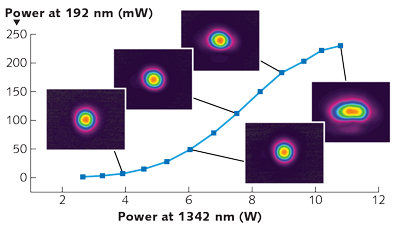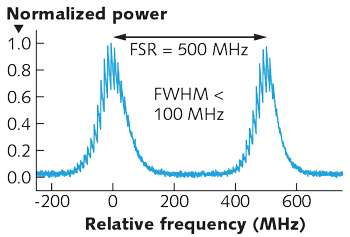Single-mode DUV
Our single-mode DUV setup is based on an injection-locked, Q-switched 1342 nm Nd:YVO4 ring laser with an average power of 13.9 W and 18.2 ns pulse duration at a pulse repetition frequency of 10 kHz.3 The pulse energy fluctuations are very low (<0.6%) and the beam quality is m2 <1.05. The seed laser is a continuous-wave (CW) single-frequency Nd:YVO4 microchip laser and the ring resonator is stabilized with the build-up time (BUT) method.
At the second harmonic, the single-mode Q-switched laser exhibits a spectral width of 45 MHz during a measurement time of 11 ms and a long-term spectral width of 75 MHz that is broadened by vibrations and the modulation of the cavity length for the stabilization via BUT reduction. The experimental setup for the conversion to the DUV spectral range is an optimized version of our broadband setup. The modulation of the cavity length for the stabilization via BUT reduction and the experimental setup for the conversion to the DUV spectral range is an optimized version of our broadband setup.
Similarly, 6HG and 7HG are conducted in a sealed box with argon purging to avoid degradation of the crystals and prisms. We used a polarization bypass of 22% in our single-mode setup. To avoid damage to the separating prism after the 7HG stage, we limited the total power after the variable attenuator to 10.8 W. At a total power of 10.8 W, our seventh-harmonic setup yields a power level of 230 mW at 191.7 nm, which corresponds to an overall efficiency of 2.13% (see Fig. 2). But because the beam quality of the seventh harmonic slightly deteriorates above a pump power of 8.94 W, this pump power level is a better choice and still results in a very respectable power level of 185 mW at 191.7 nm and overall efficiency of 2.07%. At this working point, our narrowband DUV source has 9 ns pulse duration, m2 <1.5, and very low pulse energy fluctuations of <3% because of its single-longitudinal mode operation.4

FIGURE 2. The average power at 192 nm is characterized with respect to the power at 1342 nm after the variable attenuator. The insets show the beam profile of the seventh harmonic for the corresponding output power.
Finally, our DUV source is characterized by a homemade scanning confocal Fabry-Perot interferometer (FPI) with a free spectral range of 500 MHz (see Fig. 3). For a measurement time of less than 10 ms, the spectral width is less than 100 MHz full width at half maximum (FWHM). Adding in vibrations and frequency jitter associated with resonator stabilization, long-term spectral width values are on the order of 240 MHz FWHM. Because of its high coherence at 191.7 nm, our DUV source is well suited to the inscription of long gratings in a FBG production line.

FIGURE 3. The spectral width of the 192 nm DUV source is measured with a homemade scanning confocal Fabry-Perot interferometer with a free spectral range (FSR) of 500 MHz; the duration of the measurement is less than 10 ms.
REFERENCES
1. P. Koch et al., Opt. Express, 22, 11, 13648–13658 (2014).
2. P. Koch et al., Opt. Express, 23, 10, 13648–13658 (2015).
3. P. Koch et al., Opt. Express, 23, 24, 31357–31366 (2015).
4. P. Koch et al., Appl. Opt., 55, 8, 1871–1877 (2016).

